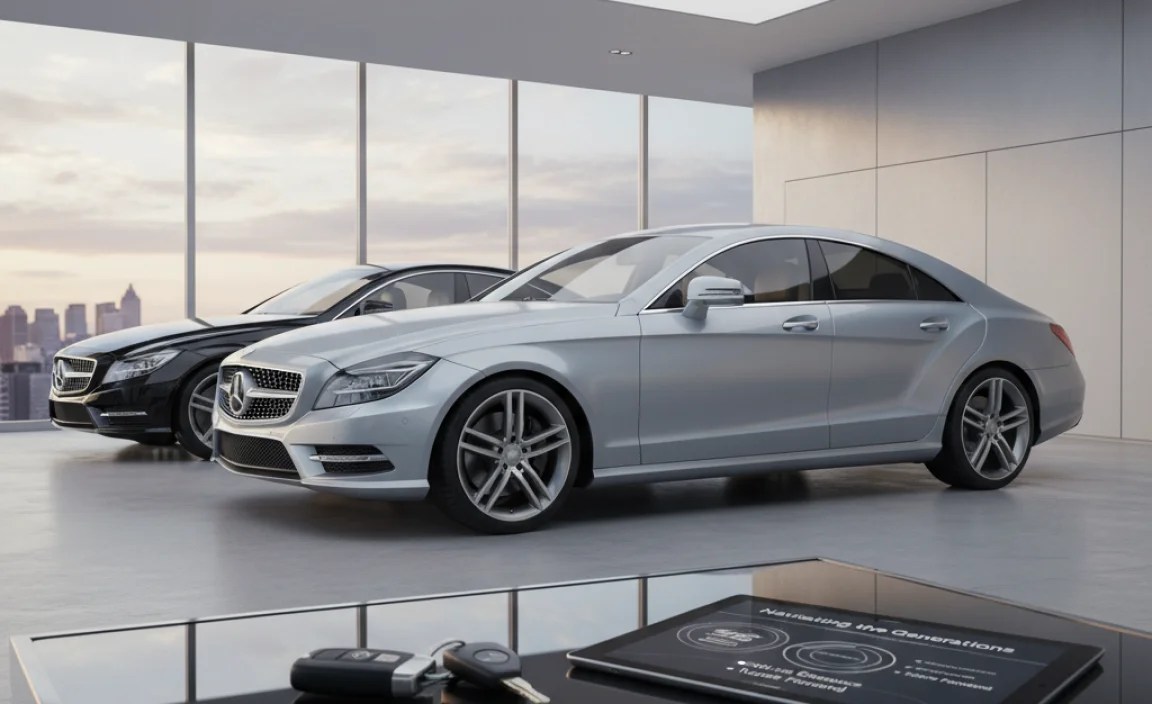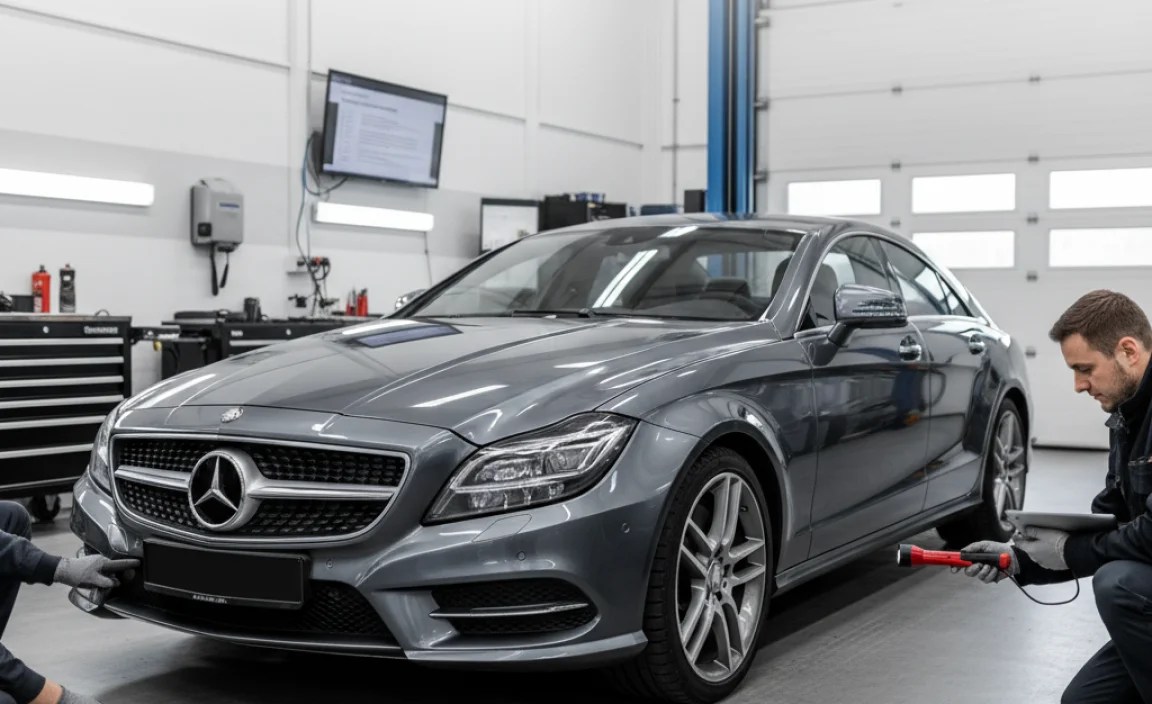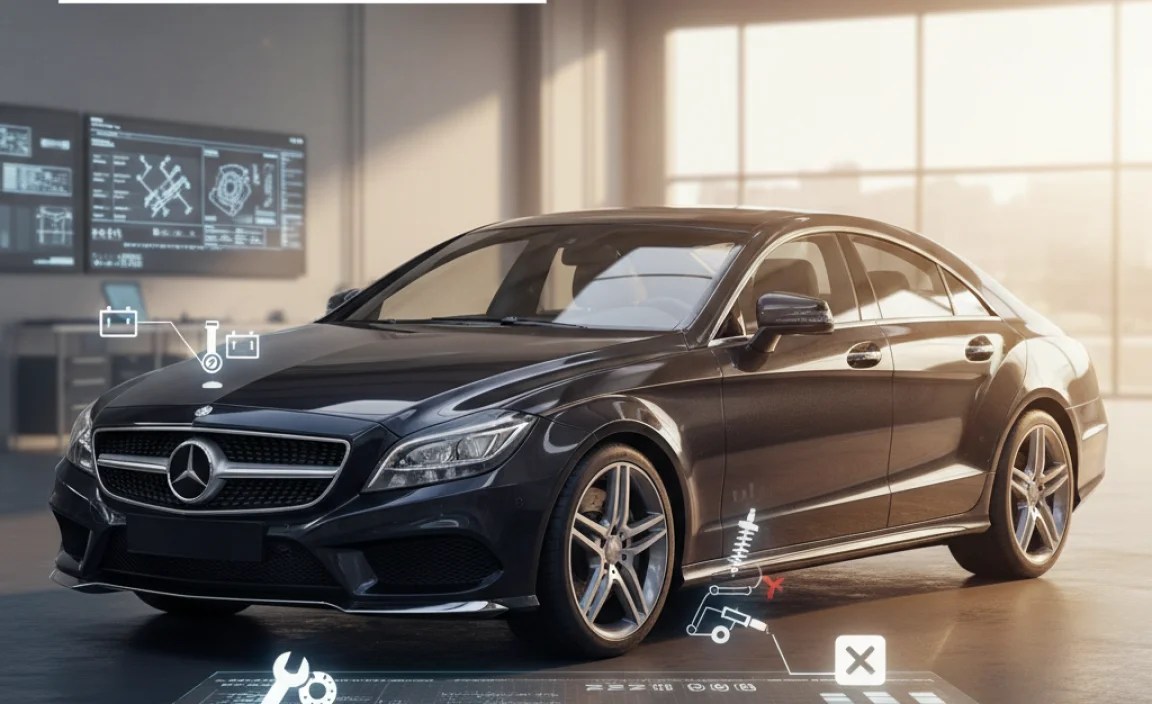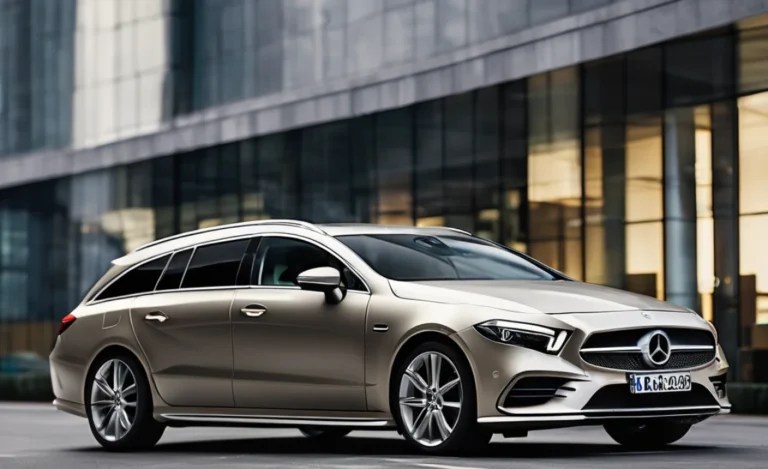CLS Class Second Hand: Effortless Luxury Awaits Your Drive
Considering a pre-owned Mercedes-Benz CLS? You’re in luck! Buying a second-hand CLS is a smart way to experience premium luxury and sophisticated design without the hefty price tag of a new model. It offers a blend of performance, comfort, and cutting-edge technology that remains impressive even years after its debut. We’ll guide you through what to look for, why it’s a great choice, and how to make your luxury purchase a smooth success. Get ready to drive in style.
The Mercedes-Benz CLS is more than just a car; it’s a statement. Known for its sleek, coupe-like silhouette and opulent interior, the CLS has always represented a unique intersection of sportiness and luxury. For those dreaming of this distinctive driving experience, a second-hand CLS offers an attainable path to premium ownership. Many find the idea of a used luxury car a bit daunting, wondering where to start or what pitfalls to avoid. You might worry about hidden issues or unexpected costs. Don’t let that stop you! This guide is designed to demystify the process, making buying a CLS Class second hand a confident and rewarding experience. We’ll cover everything you need to know, from identifying key generations to performing essential checks.
Why a Used CLS Class is a Savvy Choice

Opting for a pre-owned Mercedes-Benz CLS is a practical route to enjoying high-end automotive excellence. New luxury cars depreciate significantly in their first few years. By choosing a CLS that’s a few years old, you allow the first owner to absorb that initial depreciation, making it a much more financially sensible purchase. You still get access to Mercedes-Benz’s renowned engineering, premium materials, and advanced features, often at a fraction of the original sticker price. It’s a win-win for discerning drivers who appreciate quality and value.
A Legacy of Style and Innovation
The CLS has consistently pushed design boundaries since its introduction. It pioneered the four-door coupe segment, blending the elegance of a coupe with the practicality of a sedan. Over the years, each generation has brought new advancements in technology, safety, and performance, ensuring that even older models feel contemporary and refined. This continuous evolution means that no matter the model year you consider, you’re likely to find a car rich in features and sophisticated styling.
Cost-Effective Luxury
Luxury vehicles, by their very nature, come with premium price tags. However, the automotive market offers a fantastic opportunity to acquire a pre-owned CLS Class without breaking the bank. The significant drop in value after the first few years means that you can often find incredibly well-equipped CLS models for the price of a new mid-range car. This allows you to step into a world of superior comfort, advanced technology, and potent performance that might otherwise be out of reach.
Timeless Design Appeal
The CLS has always been lauded for its distinctive and often breathtaking design. From the original’s flowing lines to the more angular, athletic stances of later models, the CLS consistently turns heads. Its coupe-like profile, often with frameless doors and a gracefully sloping roofline, sets it apart from more traditional sedans. Choosing a used CLS means investing in a vehicle with a timeless aesthetic that continues to look modern and luxurious for years to come.
Navigating the Generations: What to Expect

The Mercedes-Benz CLS has evolved through distinct generations, each with its own character, technological advancements, and design language. Understanding these generations will help you pinpoint the model that best suits your preferences and budget.
First Generation (W219: 2004–2011)
The CLS that started it all debuted as the C219. This generation introduced the world to the four-door coupe concept from Mercedes-Benz. It was characterized by its long hood, low roofline, and a flowing, muscular body.
- Key Features: Distinctive pillarless side windows, available 4MATIC all-wheel drive, powerful V6 and V8 engines, including the stunning CLS 55 AMG and later CLS 63 AMG variants.
- What to Look For: Air suspension (AIRMATIC) can be a point of concern for wear and tear, but offers a superior ride. Check infotainment systems for functionality if you’re used to modern touchscreens.
- Pros: Unique styling, powerful engine options, a true modern classic.
- Cons: Older technology compared to newer models, potential for age-related maintenance issues.
Second Generation (W218: 2010–2018)
The W218 generation brought a more contemporary and sharper design to the CLS, while still retaining its signature silhouette. This era saw significant technological leaps and more efficient powertrains.
- Key Features: More assertive styling, advanced driver assistance systems (like DISTRONIC PLUS adaptive cruise control), improved interior technology, and a wider range of engines including diesels and more potent AMG versions (CLS 63 AMG S-Model). The Shooting Brake (X218 estate version) was also introduced in some markets.
- What to Look For: Ensure all electronic features work correctly, especially the adaptive cruise control and multimedia systems. Given its age, look for service history indicating regular maintenance.
- Pros: Modern design, excellent technology for its time, comfortable and refined driving experience, improved fuel efficiency options.
- Cons: Some find the styling less avant-garde than the original, can still be relatively expensive on the used market.
- External Link: For a deeper dive into Mercedes-Benz’s model history and specifications, the Mercedes-Benz Heritage section on their official site can be a valuable resource.
Third Generation (C257: 2018–Present)
The current generation CLS (C257) continues the four-door coupe evolution with a sleeker, more aerodynamic form and a heavily technology-focused interior.
- Key Features: MBUX infotainment system, ENERGIZING comfort control, sophisticated ambient lighting, advanced driver assistance packages, and a focus on elegant but dynamic styling. Inline-six engines with EQ Boost mild-hybrid technology became standard.
- What to Look For: While newer, ensure that software updates have been applied and all advanced electronic systems are functioning as expected. Check for any wear and tear on the premium interior materials.
- Pros: State-of-the-art technology, advanced safety features, efficient mild-hybrid powertrains, luxurious and modern interior.
- Cons: Can be the most expensive option on the used market, potentially fewer deals available compared to older generations.
Essential Checks Before You Buy a Used CLS

Buying any second-hand car requires thorough inspection, and a luxury vehicle like the CLS is no exception. A little diligence can save you significant headaches and expense down the line. Here’s your checklist:
1. Vehicle History Report
Always start with a comprehensive vehicle history report (like Carfax or AutoCheck). Look for:
- Accident history
- Title issues (salvage, flood, etc.)
- Ownership history
- Odometer discrepancies
- Service records (crucial for luxury cars)
2. Exterior Inspection
Walk around the car and look for:
- Panel Gaps: Uneven gaps can indicate previous accident repair.
- Paint Condition: Look for mismatched paint, overspray, or signs of rust, especially around wheel arches and door bottoms.
- Tires: Check for even wear. Uneven wear can signal alignment issues.
- Glass: Inspect all windows and the windshield for chips or cracks.
- Lights: Ensure all exterior lights are functioning and lenses are clear.
3. Interior Inspection
Sit in the cabin and assess:
- Upholstery: Check for tears, stains, or excessive wear on leather and other materials.
- Headliner: Look for sagging, especially around the sunroof.
- Electronics: Test everything – infotainment system, navigation, climate control, heated/ventilated seats, power adjustments for seats and mirrors, windows, sunroof, and all interior lights.
- Pedals and Steering Wheel: Excessive wear can indicate higher mileage than shown.
- Smell: Any musty or moldy odors could signify water leaks or poor ventilation.
4. Under the Hood
With the engine running (or cold, depending on your familiarity), check for:
- Fluid Levels: Oil, coolant, brake fluid, power steering fluid, and windshield washer fluid should be at appropriate levels and clean.
- Leaks: Look for any signs of fluid leaks on the engine or surrounding components.
- Belts and Hoses: Check for cracks or signs of wear.
- Battery: Look for corrosion on the terminals. A failing battery can cause electrical gremlins.
5. Powertrain and Drivetrain
This is where a pre-purchase inspection (PPI) by a qualified mechanic is invaluable. However, you can do some initial checks:
- Engine Noise: Listen for any knocking, ticking, or unusual sounds.
- Transmission: During the test drive, ensure shifts are smooth and without hesitation.
- Brakes: Feel for pulsations or grinding when braking.
- Suspension: Listen for clunks or rattles over bumps.
6. Test Drive
This is your opportunity to feel the car. Drive it in various conditions:
- Start-up: Does it start easily and run smoothly?
- Acceleration: Is it smooth and responsive?
- Braking: Does it pull to one side? Is the pedal firm?
- Steering: Is it precise? Any looseness or strange noises when turning?
- Suspension: Drive over speed bumps and uneven surfaces.
- Noise: Listen for wind noise, road noise, or any other unusual sounds at different speeds.
Tip: If the car is equipped with AIRMATIC suspension, listen for any hissing sounds when the engine is off or on startup, which could indicate a leak. Also, check if the car maintains its ride height after being parked.
The Pre-Purchase Inspection (PPI): Your Best Friend

Even after your own thorough inspection, a pre-purchase inspection (PPI) by a certified Mercedes-Benz specialist or a trusted independent mechanic is highly recommended. They have the specialized tools and expertise to identify issues you might miss, such as:
- Diagnosing engine and transmission computer codes.
- Thoroughly checking the AIRMATIC suspension system.
- Inspecting the braking system components (pads, rotors, lines).
- Examining the exhaust system for leaks or damage.
- Assessing the condition of vital engine components.
- Checking for signs of serious mechanical wear.
The cost of a PPI (typically $100-$300) is a small investment compared to the potential repair bills for a luxury car. A reputable mechanic can give you an unbiased assessment of the car’s condition and highlight any immediate or future repair needs. For more information on what to expect from a mechanic, resources like AutoMD’s guide to pre-purchase inspections can be very informative.
Common Issues and Maintenance Considerations

While Mercedes-Benz vehicles are built to a high standard, certain components can be prone to wear or issues over time, especially on older models. Being aware of these can help you assess a potential purchase and budget for future maintenance.
Air Suspension (AIRMATIC)
Found on many CLS models, AIRMATIC provides a supremely comfortable ride but can be expensive to repair if it fails. Common issues include leaking air springs, compressor failure, or sensor problems. Look for a car that maintains its height and doesn’t sag.
Electronics and Sensors
Modern luxury cars are complex. Sensors for everything from engine management to advanced driver aids can fail. Electrical gremlins can be frustrating and costly to diagnose. Ensure all electronic features are tested thoroughly.
Transmission Issues
While generally robust, the transmission can experience issues, particularly if maintenance has been neglected. Slipping, rough shifts, or delayed engagement are red flags. Regular transmission fluid changes are crucial.
Oil Leaks
Older engines, especially V-engines, can develop oil leaks from valve cover gaskets, oil cooler seals, or the infamous “balance shaft seal” on some AMG models. These often require significant labor to repair.
Interior Wear
High-quality materials like leather can show wear over time, especially on the driver’s seat bolsters, steering wheel, and armrests. The infotainment screens on older models may also develop dead pixels or backlight issues.
Maintenance Records are Key
A CLS Class second hand with a complete and documented service history from a Mercedes-Benz dealership or a reputable independent specialist is always preferable. This indicates the car has been well-cared for and ensures that critical maintenance intervals have been met. For example, timely fluid changes for the engine, transmission, and differential can prevent costly failures.
Performance Variants: AMG CLS
For those seeking exhilarating performance, the AMG CLS variants offer a significant step up in power and driving dynamics. These are highly desirable but also come with higher purchase prices and potentially higher running costs.
Key AMG Considerations:
- Engine: AMG models often feature hand-built V8 engines known for their immense power but require specialist care and may be more prone to certain wear issues (like head bolt issues on some older M156 engines) than standard models.
- Suspension: AMG cars often have a firmer, sport-tuned suspension, which can be less comfortable for daily driving but offers superior handling.
- Brakes: Upgraded braking systems are standard, but replacement parts can be expensive.
- Maintenance: Regular servicing by AMG specialists is crucial. Costs for parts and labor will be higher than for standard CLS models.
If considering an AMG, factor in the increased cost of insurance, fuel consumption, and specialized maintenance. It’s also wise to ensure the vehicle has been driven and maintained with respect to its performance capabilities.
Pricing and Value
The market price for a CLS Class second hand can vary significantly based on several factors:
- Year and Generation: Newer models and the latest generation will command higher prices.
- Mileage: Lower mileage generally means a higher price.
- Condition: Excellent cosmetic and mechanical condition is key.
- Trim Level and Options: Higher trim levels, premium packages (like AMG Line, Burmester sound system), and rare options will increase value.
- Location: Regional market demand can influence pricing.
- AMG Models: These will always be at the top of the price spectrum.
A general price range might look something like this, though actual prices will vary:
| Model Year Range | Approximate Price Range (USD) | Notes |
|---|---|---|
| 2005-2011 (W219) | $8,000 – $18,000 | Entry-level luxury, classic design. Older tech. |
| 2011-2018 (W218) | $15,000 – $35,000 | More modern features, advanced tech for its era. AMG models higher. |
| 2018-Present (C257) | $30,000+ | Latest tech, significantly more expensive, hybrid tech. |
| AMG Variants (Across Generations) | Varies widely, often $10,000+ above equivalent non-AMG | High performance, higher running costs, enthusiast appeal. |
Disclaimer: These are rough estimates and actual prices will fluctuate greatly based on the specific vehicle and market conditions. It’s essential to research current listings on reputable automotive sales websites (e.g., AutoTrader, Cars.com), and check auction sites for the most accurate current market values.
Conclusion: Embrace Your Luxury Drive
Purchasing a CLS Class second hand opens the door to sophisticated motoring, impressive performance, and unmistakable style, all while being a financially astute decision. By understanding the different generations, performing diligent pre-purchase checks, and potentially enlisting the expertise of a trusted mechanic, you can confidently navigate the used





